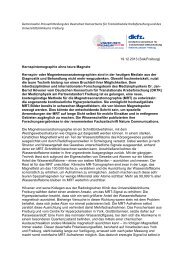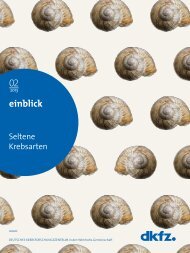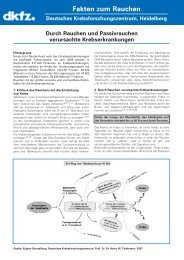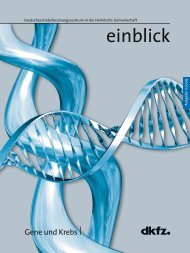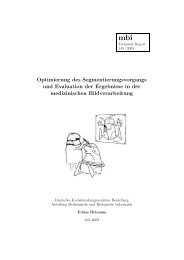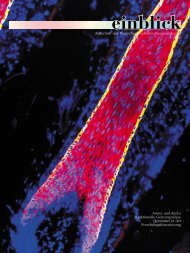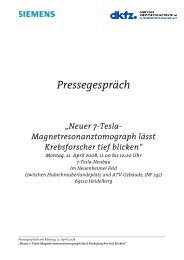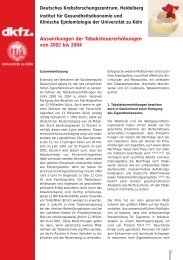MDCK-MRP2 - Dkfz
MDCK-MRP2 - Dkfz
MDCK-MRP2 - Dkfz
Erfolgreiche ePaper selbst erstellen
Machen Sie aus Ihren PDF Publikationen ein blätterbares Flipbook mit unserer einzigartigen Google optimierten e-Paper Software.
Forschungsschwerpunkt E<br />
Innovative Krebsdiagnostik und -therapie<br />
wiesen werden, dass Patientinnen mit Zervixkarzinomen<br />
eine humorale Immunantwort gegen p16ink4a entwickeln,<br />
die von diagnostischem und eventuell prognostischem Wert<br />
für die Beurteilung von Patienten mit Präneoplasien sein<br />
könnte (Linnebacher et al., Manuskript in Vorbereitung).<br />
Entwicklung einer Antigen-spezifischen Vakzine<br />
mit CTA1-DD Fusionsproteinen in einem Rattenmodell<br />
der DMH-induzierten kolorektalen<br />
Karzinogenese<br />
CTA1-DD ist eine Kombination aus Teilen des Choleratoxins,<br />
das starke adjuvante Eigenschaften hat, und des Proteins<br />
A von S. aureus, das eine Ig-Bindungsdomäne besitzt. Das<br />
Fusionsprotein wird gegenwärtig benutzt, um effiziente<br />
Vakzinen gegen verschiedene mikrobielle Antigene zu entwickeln.<br />
In dieser Studie untersuchen wir den Einsatz des<br />
CTA1-DD Fusionsproteins als Adjuvanz für die Entwicklung<br />
einer therapeutischen, antigen-spezifischen Kolonkarzinomvakzine.<br />
Wir haben mehrere tumorspezifischen Antigene in einem<br />
bekannten Ratten-Modellsystem von chemisch induzierten<br />
Kolontumoren und der aus diesem Modell abgeleiteten<br />
Zelllinie CC531 identifiziert [7, 19], unter diesen mutierte<br />
Onkogene wie k-ras oder β-Catenin und tumorspezifisch<br />
überexprimierte Gene wie cyclin E, p16ink4a, BNP, und<br />
WT1, die auch als relevante Tumor-Antigene in menschlichen<br />
Kolon- und anderen soliden Tumoren gefunden wurden<br />
[52 21, 22]. Diese Modellantigene werden zur Zeit<br />
auf ihre Fähigkeit untersucht, eine effiziente antitumorale<br />
Immunantwort in Ratten zu erzeugen, zunächst in einem<br />
therapeutischen und dann in einem präventiven Ansatz.<br />
Publikationen<br />
[1] Bonk, T. et al. Matrix-assisted laser desorption/ionization<br />
time-of-flight mass spectrometry-based detection of microsatellite<br />
instabilities in coding DNA sequences: a novel approach<br />
to identify DNA-mismatch repair-deficient cancer cells.<br />
Clin.Chem. 49.4 (2003): 552-61.<br />
[2] Bonk, T. et al. Molecular diagnosis of familial adenomatous<br />
polyposis (FAP): genotyping of adenomatous polyposis coli (APC)<br />
alleles by MALDI-TOF mass spectrometry. Clin.Biochem. 35.2<br />
(2002): 87-92.<br />
[3] Dihlmann, S., S. Klein, and M. von Knebel Doeberitz. Reduction<br />
of beta-catenin/T-cell transcription factor signaling by aspirin<br />
and indomethacin is caused by an increased stabilization of phosphorylated<br />
beta-catenin. Mol.Cancer Ther. 2.6 (2003): 509-16.<br />
[4] Dihlmann, S., A. Siermann, and Doeberitz M. von Knebel. The<br />
nonsteroidal anti-inflammatory drugs aspirin and indomethacin<br />
attenuate beta-catenin/TCF-4 signaling. Oncogene 20.5 (2001):<br />
645-53.<br />
[5] Foulkes, W. D. et al. The founder mutation MSH2*1906G->C<br />
is an important cause of hereditary nonpolyposis colorectal cancer<br />
in the Ashkenazi Jewish population. Am.J.Hum.Genet. 71.6<br />
(2002): 1395-412.<br />
[6] Gebert, J. et al. Molecular profiling of sporadic colorectal tumors<br />
by microsatellite analysis. Int.J.Oncol. 16.1 (2000): 169-<br />
79.<br />
[7] Germann, A. et al. Expression profiling of CC531 colon carcinoma<br />
cells reveals similar regulation of beta-catenin target genes<br />
by both butyrate and aspirin. Int.J.Cancer 106.2 (2003): 187-<br />
97.<br />
[8] Grips, E. et al. [Glioblastoma multiforme as a manifestation of<br />
Turcot syndrome]. Nervenarzt 73.2 (2002): 177-82.<br />
[9] Gurrola-Diaz, C. et al. Reduced expression of the neuron restrictive<br />
silencer factor permits transcription of glycine receptor<br />
alpha1 subunit in small-cell lung cancer cells. Oncogene 22.36<br />
(2003): 5636-45.<br />
E110<br />
Gentherapie von Tumoren<br />
[10] Kalka, D. et al. The plasma membrane ganglioside sialidase<br />
cofractionates with markers of lipid rafts.<br />
Biochem.Biophys.Res.Commun. 283.4 (2001): 989-93.<br />
[11] Keller, M. et al. Comprehensive genetic counseling for families<br />
at risk for HNPCC: impact on distress and perceptions.<br />
Genet.Test. 6.4 (2002): 291-302.<br />
[12] Keller, M. et al. Acceptance of and attitude towards genetic<br />
for HNPCC: a comparison of participants and non-participants in<br />
genetic counselling. Dis.Colon Rectum 47 (2004): 153-62.<br />
[13] Kienle, P. et al. Decreased detection rate of disseminated<br />
tumor cells of rectal cancer patients after preoperative chemoradiation:<br />
a first step towards a molecular surrogate marker for<br />
neoadjuvant treatment in colorectal cancer. Ann.Surg. 238.3<br />
(2003): 324-30.<br />
[14] Kienle, P. et al. Detection of isolated disseminated tumor<br />
cells in bone marrow and blood samples of patients with hepatocellular<br />
carcinoma. Arch.Surg. 135.2 (2000): 213-18.<br />
[15] Klaes, R. et al. p16INK4a immunohistochemistry improves<br />
interobserver agreement in the diagnosis of cervical intraepithelial<br />
neoplasia. Am.J.Surg.Pathol. 26.11 (2002): 1389-99.<br />
[16] Klaes, R. et al. Overexpression of p16(INK4A) as a specific<br />
marker for dysplastic and neoplastic epithelial cells of the cervix<br />
uteri. Int.J.Cancer 92.2 (2001): 276-84.<br />
[17] Koch, M. et al. Hematogenous tumor cell dissemination during<br />
colonoscopy for colorectal cancer. Surg.Endosc. 18.4 (2004):<br />
587-591.<br />
[18] Koch, M. et al. Comparative analysis of tumor cell dissemination<br />
in mesenteric, central, and peripheral venous blood in patients<br />
with colorectal cancer. Arch.Surg. 136.1 (2001): 85-89.<br />
[19] Koesters, R. et al. Predominant mutation of codon 41 of the<br />
beta-catenin proto-oncogene in rat colon tumors induced by 1,2dimethylhydrazine<br />
using a complete carcinogenic protocol. Carcinogenesis<br />
22.11 (2001): 1885-90.<br />
[20] Koesters, R. et al. WT1 is a tumor-associated antigen in colon<br />
cancer that can be recognized by in vitro stimulated cytotoxic<br />
T cells. Int.J.Cancer 109.3 (2004): 385-92.<br />
[21] Koesters, R. et al. Nuclear accumulation of beta-catenin<br />
protein in Wilms’ tumours. J.Pathol. 199.1 (2003): 68-76.<br />
[22] Koesters, R. and Doeberitz M. von Knebel. The Wnt signaling<br />
pathway in solid childhood tumors. Cancer Lett. 198.2<br />
(2003): 123-38.<br />
[23] Kopitz, J. et al. Homodimeric galectin-7 (p53-induced gene<br />
1) is a negative growth regulator for human neuroblastoma cells.<br />
Oncogene 22.40 (2003): 6277-88.<br />
[24] Kopitz, J., C. Oehler, and M. Cantz. Desialylation of extracellular<br />
GD1a-neoganglioprotein suggests cell surface orientation<br />
of the plasma membrane-bound ganglioside sialidase activity in<br />
human neuroblastoma cells. FEBS Lett. 491.3 (2001): 233-36.<br />
[25] Lacroix, J. et al. Sensitive detection of rare cancer cells in<br />
sputum and peripheral blood samples of patients with lung cancer<br />
by preproGRP-specific RT-PCR. Int.J.Cancer 92.1 (2001): 1-8.<br />
[26] Linnebacher, M. et al. Frameshift peptide-derived T-cell<br />
epitopes: a source of novel tumor-specific antigens. Int.J.Cancer<br />
93.1 (2001): 6-11.<br />
[27] Luft, F. et al. Detection of integrated papillomavirus sequences<br />
by ligation-mediated PCR (DIPS-PCR) and molecular<br />
characterization in cervical cancer cells. Int.J.Cancer 92.1<br />
(2001): 9-17.<br />
[28] Oehler, C., J. Kopitz, and M. Cantz. Substrate specificity<br />
and inhibitor studies of a membrane-bound ganglioside sialidase<br />
isolated from human brain tissue. Biol.Chem. 383.11 (2002):<br />
1735-42.<br />
[29] Plaschke, J. et al. Eight novel MSH6 germline mutations in<br />
patients with familial and nonfamilial colorectal cancer selected by<br />
loss of protein expression in tumor tissue. Hum.Mutat. 23.3<br />
(2004): 285.<br />
DKFZ 2004: Wissenschaftlicher Ergebnisbericht 2002 - 2003<br />
349



